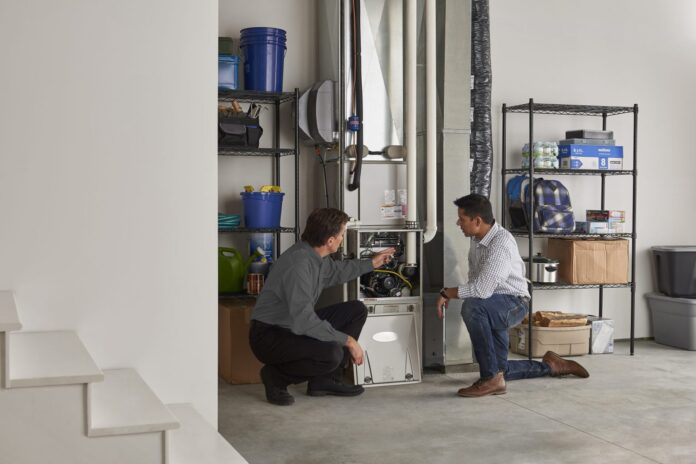Furnaces are essential for day-to-day comfort for your family, and they are a significant investment in your residence. When considering a furnace upgrade or installation, it makes sense to research your options thoroughly. In addition to improving your home’s comfort, several factors to consider may also help lower energy costs.
Different types of furnaces
Forced air and radiant (or boiler) heating are the two most common types of home heating. The heated air must be pushed through ductwork during forced air systems. The heated air is distributed throughout your house through ductwork. A radiant heating system can take some forms. Typically, water (steam) heated by boilers is transferred to radiators (or baseboards) via a series of pipes. Radiators and baseboards provide heating wherever they are located. The hot water tubing buried beneath the floor surface can also transfer heat from radiant heaters to a floor.
Electric furnace
For areas without severe winter weather, electric furnaces are a great option. Generally, electric furnaces are less expensive to purchase upfront than gas furnaces. They are, however, more costly to operate due to the high costs of electricity. They do, however, have a reputation for having good energy efficiency. The efficiency of electric furnaces is exceptionally high in regions with temperatures above freezing. The size (typically small) and installation ease of electric furnaces are also advantages. Furthermore, these furnaces do not require any special venting or piping, are easy to maintain, and can last up to 15-20 years.
Gas furnace
A gas furnace is the most popular type and is an excellent choice for climates with harsh winters. The upfront cost of a gas furnace is higher than that of an electric model. But the monthly operating expenses of the gas furnace remain lower. In addition, gas furnaces heat your home quickly, thanks to their efficiency. The costs associated with installing, replacing, and maintaining gas furnaces differ from electric furnaces. In the case of gas furnaces, the ductwork needs to be cleaned regularly, the central unit must be inspected annually, and filters need to be replaced.
Oil furnace
The volatility in oil prices has made oil furnaces less popular than they once were. Nevertheless, they are an excellent choice for regions with harsh winters. Fuel storage tanks are needed with oil furnaces, adding to the cost and space requirements. On the other hand, you don’t incur monthly operating costs since you only pay for oil when the tank is full. Oil tanks are typically filled quarterly, semiannually, or even annually, depending on their size.
What is the average cost of a furnace?
Depending on the type of furnace you select, the price of your new or replacement furnace will also vary. Based on furnace type, HomeAdvisor provides nationwide average pricing. The cost to install a gas furnace ranges from $3,800 to $10,000. Installation fees for electric furnaces range from $2,000 to $7,000. Installing an oil furnace might cost anywhere from $6,750 to $10,000. Consult an HVAC expert for the most accurate cost in your region.
Several factors affect costs, including the location, local climate, type and brand of the system, the installer’s experience, the size of your home, and whether or not ductwork must be performed. Furnace installation costs will skyrocket if your home requires extensive electrical or ductwork.
Your town may require you to obtain a permit before installing a furnace, depending on where you live. As little as $50 or as much as hundreds of dollars can be spent. Depending on your local bylaws, arranging an inspection from your municipality or city may also be necessary.
Installation of a Furnace
Installing a furnace is a complex undertaking and should not be attempted by a do-it-yourselfer. Although it might seem convenient to cut costs on the installation, furnaces contain several complicated components, including electrical, ductwork, plumbing, and gas, which require an HVAC expert’s expertise and specialized tools. In the meantime, please find below a step-by-step breakdown of the furnace installation process. Our example uses a gas furnace that is common among homeowners.
Step 1: Make your furnace selection and decide where to install it.
Selecting a suitable location for your furnace will depend on the type of furnace you choose. Choosing the appropriate space depends mainly on the type of furnace and what you plan to do with the rest of the room. Each stove has installation instructions included with it. Therefore, each furnace includes information about clearance requirements and ventilation requirements. It would help if you cleaned the area of dust and debris before starting the furnace installation process.
Basement furnaces should be installed on blocks at least 4 inches above the ground to prevent flooding. Purchase some rubber isolation pads if your furnace did not come with them. These will help reduce noise when the furnace runs. Remove all loose parts and instructions from your new furnace.
Step 2: Decide where you want your drain and duct to run.
You must cut a hole in the unit to install the return air duct. The return air duct can be located on the bottom or side of the team. In most cases, an appropriate opening size is indicated on the chimney. The next step is to decide which side of the duct the condensate drain should run. Orient your furnace to nearly level and slope slightly towards the condensate drain.
Step 3: The ducting system must be connected.
Connect your home’s ducting system to the furnace once it has been installed correctly and adequately. Please don’t use duct tape for this step because it won’t last. Instead, use metal foil tape or duct sealant to seal all connections.
Step 4: Connect the vent pipes
Install your furnace’s intake and exhaust pipes on an angle sloping toward the unit to ensure condensation can effectively drain.
Step 5: Connect the gas supply
After you’ve shut the system off and ventilated it, be sure to check for leaks.
Read More: Each And Everything You Need To Know About Sump Pump Replacement
Step 6: Connect the electrical supply
Most furnaces have two connections, one for low voltage and one for line voltage. When this step is performed, you should pay special attention to polarity. Before starting your new furnace for the first time, ensure your wiring follows the instructions.
Step 7: Connect the condensate drain
The water usually drains into a drain in the basement floor via a hose.
Step 8: Check your work
As part of furnace installation, the unit must be turned on and run through a heating cycle for the temperature outputs to be where they should be. Allow the furnace to run for about an hour before checking the temperature. Ensure that the condensate drain is draining correctly and check for gas leaks.
Furnace installation represents a challenging endeavor with many complex steps that require the expertise of HVAC professionals. This list provides homeowners with a general idea of what will be involved in installing their furnaces.
Repair options for furnaces
If you are a weekend DIYer, you can perform tasks such as changing your furnace’s air filter and identifying an empty fuel oil tank. Still, significant repairs should be left to qualified home heating professionals. Ensure you schedule an annual furnace maintenance appointment to ensure everything functions correctly. The benefits of annual furnace maintenance include saving on monthly heating costs and extending the furnace’s life.
FAQs
- Installing a furnace should cost approximately how much?
In the United States, the average cost of installing a complete furnace ranges from $4,820 to $9,350. The price for installation includes the stove itself, labor fees, ductwork, removal, and disposal of the old furnace, as well as any other items included in the building or upgrade.
- Is it possible to install a furnace yourself?
The savings do not outweigh the risks involved in installing a furnace yourself. If you need furnace installation, repair, or maintenance, you should always hire a qualified HVAC contractor.
- Are there any furnace installations I can do myself?
A furnace installed yourself is not worth the risk compared to the money saved. If you are installing, repairing, or maintaining a furnace, hiring a qualified and professional HVAC contractor is always best. For example, a 700- to 1,500-square-foot home will require a BTU rating between 40,000 and 60,000, which will cost between $2,000 and $3,000.












